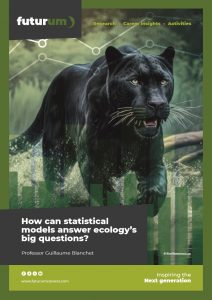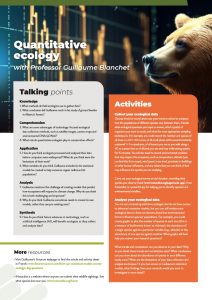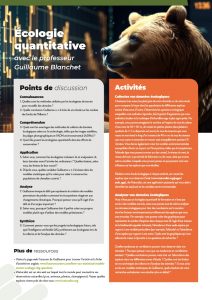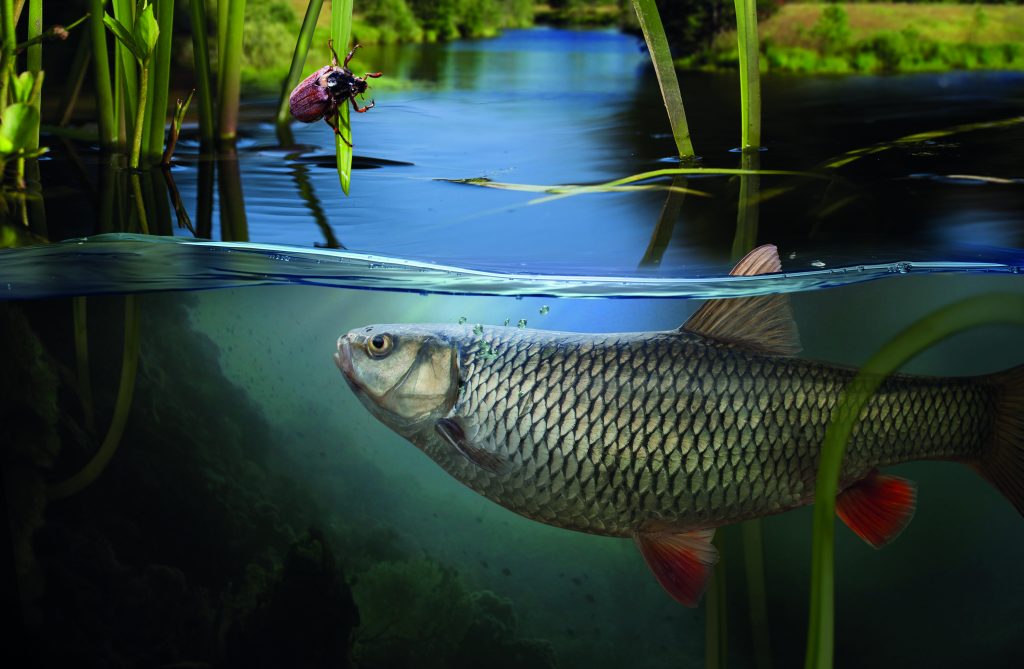How can statistical models answer ecology’s big questions?
Ecology involves studying the interactions between living things and their environment. These interconnections can be very complex, leading to the creation of some hefty datasets. At the Université de Sherbrooke in Canada, Professor Guillaume Blanchet specialises in building sophisticated statistical models that can analyse these datasets, producing fascinating and unexpected results.
Talk like a quantitative ecologist
Ecology — the branch of biology that studies the relationships organisms (including humans) have with each other and their environments
Ecosystem — all the living and non-living components of an environment
Endangered species — a species at risk of going extinct
Invasive species — a species not native to the region in which it is now found, usually introduced there (intentionally or accidentally) by humans
Quantitative ecology — the branch of ecology that uses statistical and mathematical models to study ecological systems
Statistical model — a mathematical model that relies on observed data to better understand and predict events
Variable — a component in a model that can take on different values, e.g., altitude or temperature
While the popular image of ecology may involve scientists tramping around fields and forests armed with measuring tapes and butterfly nets, this picture is only the first half of the story. Once an ecologist has collected samples and measurements from the field, the next job is to analyse these data to discover what they tell us about ecosystems. And this is where quantitative ecologists, such as Professor Guillaume Blanchet at the Université de Sherbrooke, come in.
Quantitative ecology involves taking the complex datasets generated by field ecologists and creating statistical models to uncover secrets the data hold. As ecological studies often generate complex datasets that must be analysed, quantitative ecologists are in high demand, and Guillaume has worked on a wide range of projects, from investigating the population dynamics of bighorn sheep to conserving endangered fish species to modelling bird migration.
From the field…
Ecologists are interested in how living organisms interact with each other and their environments. Studying these relationships involves data collection, which can take a variety of forms. “Many ecologists still collect data ‘manually’, by going into the field and using techniques such as traps or active sampling techniques (to collect animals or plants), tagging (to track and monitor animals) and species surveys (to study animals, plants and other organisms),” says Guillaume. “This might involve catching butterflies by brushing nets over vegetation, identifying all the plants in a specific area, or tagging a migratory bird to monitor its movements.”
Increasingly, ecology is benefitting from advances in technology. For example, satellite imagery can be used to measure forest cover, algal blooms or even the locations of large animals, such as whales, from space. Motion-sensitive camera traps can automatically record the wildlife passing through an area when scientists are not present to observe them. Environmental DNA (eDNA) involves taking soil or water samples and using sophisticated lab techniques to identify the origin of the small fragments of DNA found within them, providing a powerful way to understand what organisms are in an area without ever seeing them.
Some ecological methods include conducting experiments to manipulate the environment, such as modifying the amount of water plants receive, to investigate how organisms respond. Others rely on citizen science, in which the public participate in science projects by gathering ecological information, for example, by recording animal sightings. “These are just a few examples,” says Guillaume. “Ecological data gathering techniques are really diverse, and ecologists are constantly developing new methods. My colleague studies ants, and he loves to browse in hardware stores and think about how he could use the equipment there to gather data in new ways!”
… to the computer
Effectively processing and analysing the datasets generated by these ecological data collection techniques relies on specialised skills. “Statistical models help us answer ecological questions and give a measure of the certainty of the answers,” says Guillaume. “For example, I could record when the flowers in my garden bud every year. Because some years are warmer than others, the budding time may fluctuate when we compare data from different years, so we need to account for this uncertainty. Statistical models help us identify trends in data and the level of uncertainty.”
This is a simple example, and models can undertake much more complex tasks. For instance, there may be many more variables involved that affect flower budding – how much sunlight or rainfall they receive, what soil they are growing in, what pests or diseases are around, and so on. As ecological data collection is increasingly conducted using technological methods, which can capture vast amounts of data, the need to account for the complexity of these data only grows.
Models and efficiency
“When I receive an ecological dataset, the first thing I do is to work with my colleagues who gathered the data to understand the details of what they did when sampling the data,” says Guillaume. “I then consider which statistical models would best answer the question they had when sampling the data and implement the analysis by running the models using computer programs.”
Reference
https://doi.org/10.33424/FUTURUM448
While many statistical models already exist, some datasets require new approaches to answer specific questions. Guillaume develops his own models to achieve this, which requires knowledge of algebra, statistics and probability. “My models have been applied to better understand where species should (or should not) occur, how they interact with other species, and what components of the environment influence their distribution,” he says. “If we can understand what features of an environment are favourable for a particular species, we can help conserve it if it is endangered or control it if it is invasive.”
A big challenge for ecology is that the collection of data can often take up a lot of funding, time and resources. “I aim to develop a more efficient way to sample ecological data that would require less effort and still give the same results,” says Guillaume. “I’ve found that some studies would produce the same results if only a fraction of the sampled data had been collected.” These findings are contributing to making ecology an increasingly efficient and effective discipline.
Best of the beetles
Guillaume’s work has introduced him to some fascinating collaborations. “I worked with a colleague who is an expert on ground beetles in the boreal forests of northern Alberta, Canada,” he says. “We wanted to understand how commercial forests, where logging takes place, can be managed to ensure biodiversity is protected.” Guillaume used statistical models that incorporated data on a wide range of species and discovered that, to effectively preserve beetle biodiversity in northern Alberta, areas of forest left uncut must be at least 1 km2 in size. “This result was quite surprising for us!” he says.
In another study, Guillaume collaborated with two teams of researchers from Finland and Japan to compare their data on a group of insects known as oak leaf miners. “We wanted to understand if the factors that affect the abundance of these insects through time are the same in different regions of the world,” says Guillaume. “Both teams had worked on their respective projects for many years and had gathered large quantities of data.” Guillaume built a sophisticated statistical model that could account for all the different types of data, combining all the information in a single model. “Our model indicated that some factors, including the insects’ microhabitats, anatomy and behaviour, correlate with fluctuations in species’ populations over time,” says Guillaume. “On the other hand, other characteristics, such as the frequency of reproduction and the species’ mode of feeding, did not.”
Statistical models are the only way to uncover such findings. Without them, and without quantitative ecologists such as Guillaume, these ecological secrets would remain hidden in the data forever.
 Professor Guillaume Blanchet
Professor Guillaume Blanchet
Assistant Professor, Department of Biology and Department of Mathematics, Université de Sherbrooke, Canada
Field of research: Quantitative ecology
Research project: Developing statistical models to uncover the complex relationships organisms have with each other and their environment
Funder: We acknowledge the support of the Natural Sciences and Engineering Research Council of Canada (NSERC)/Nous remercions le Conseil de recherches en sciences naturelles et en génie du Canada (CRSNG) de son soutien
About quantitative ecology
Quantitative ecology involves using statistics and other mathematical tools to answer ecological questions. While quantitative ecologists tend not to gather data themselves, they work closely with field ecologists to process their datasets and discover what they contain. “The best thing about my work is that I get to learn about the immense diversity of life on Earth,” says Guillaume. “As my work focuses on ecological methods, rather than a specific ecological system, I have contributed to research about lions, jaguars, bighorn sheep, birds, coral, algae, insects, crayfish, freshwater fish (including the copper redhorse, an endangered species found only in Quebec, Canada), marine organisms, desert and arctic plants, and tropical and boreal trees. On every project, I work with specialists who teach me something new every day. It’s also thrilling to use models to find out things that nobody ever knew before.”
What does the future hold for quantitative ecologists?
Climate change is affecting biodiversity in significant and unexpected ways. To conserve species and ecosystems, quantitative ecologists must develop statistical models that can efficiently predict how organisms and environments will respond to future changes. “It is hugely challenging to create models that can predict what will happen in the next 10 to 100 years, especially due to the unprecedented nature of climate change and its often-unexpected impacts on biodiversity,” says Guillaume.
As technology continues to advance, new techniques for gathering ecological data will present new challenges for quantitative ecologists as they try to analyse them. For example, LiDAR (the use of lasers to determine the physical characteristics of the environment, including the vegetation) and eDNA data require new analysis methods and new statistical modelling techniques.
One area of focus in quantitative ecology is the development of a single all-encompassing model that could account for the entire complexity of a whole ecosystem. “This is very appealing,” says Guillaume. “However, it is also very challenging. At the moment, we simply don’t have the computational power to develop such models.”
What skills do quantitative ecologists need?
“First and foremost, you need to be passionate about the environment and everything that lives in it. Don’t hesitate to wonder about the beauty and complexity of nature,” says Guillaume. “Ecologists are some of the most passionate people I have met. They are highly invested in making the world a better place.” Knowledge of mathematics and computer programming is also essential for developing the models used by quantitative ecologists. While field ecologists may spend their days measuring trees in the rainforest or hunting lizards in the desert, the quantitative side of the subject provides a route into ecology for those who do not want to, or cannot, participate in fieldwork, creating accessible opportunities for anyone to contribute to conservation efforts.
Explore careers in quantitative ecology
• “Now, more than ever, people are realising that climate change is affecting our lives and the planet,” says Guillaume. “Companies and governments want to know how to manage the situation, which requires gathering and processing data on the natural world.” This means there is an ever-increasing need for ecologists, especially quantitative ecologists, who can analyse these data and understand and explain the results.
• Many private sector companies employ ecologists, so you could work as an ecologist in construction, mining, forestry, manufacturing or insurance. Ecologists also work for governments and non-governmental organisations that advocate for the natural world.
• Two of the largest ecological societies both have sections dedicated to quantitative ecology. The Ecological Society of America’s Statistical Ecology Section (www.esa.org/stats) and the British Ecological Society’s Quantitative Special Interest Group (www.britishecologicalsociety.org/membership-community/special-interest-groups/quantitative-ecology) each provide opportunities for prospective quantitative ecologists to network, learn and attend events.
Pathway from school to quantitative ecology
• At school and post-16, study biology, mathematics and computer programming to learn about ecology and statistical modelling.
• At university, a degree in ecology, biology, environmental science, conservation, mathematics, statistics or computer science could lead to a career in quantitative ecology.
Meet Guillaume
What were your interests when you were younger?
I had many interests as a kid, ranging from video games to basketball. I was always interested in science, beginning with dinosaurs and then evolution. I had a book on evolution that I read as often as I read my Astérix and Tintin comic books.
Who inspired you to become a quantitative ecologist?
When I finished high school, I knew I wanted to be a researcher. Back then, medical science was the only scientific field I was aware of, but I didn’t get the grades I needed to study medicine at university. Instead, I studied biology, where I discovered the possibility of a career in ecology. During my degree, I met Professor Pierre Legendre who founded the field of numerical ecology, and who is an amazing ambassador for ecologists who want to do quantitative work.
What are your favourite ecology projects to work on?
I am always interested in learning about new things, so being able to work on such a range of ecological systems and species is amazing. The projects that most stand out to me are those where I could develop a new method that had never been thought of before, or else when I could use existing methods in entirely new ways. I love the fact that, in most of our projects, results are rarely what we expect them to be!
What do you enjoy doing in your free time?
Outside of work, I love spending time with my family. I particularly enjoy kayaking with my sons.
Guillaume’s top tips
1. Be passionate and don’t be scared to follow your dreams.
2. There is never only one way to reach where you want to go. I always loved math and nature, but never realised I could make a living by combining these two passions.
Do you have a question for Guillaume?
Write it in the comments box below and Guillaume will get back to you. (Remember, researchers are very busy people, so you may have to wait a few days.)








Dear ProfessorGuillaume,
I am writing to congratulate you and thank you for your inspiring work in quantitative ecology and the development of statistical models applied to the study of interactions between organisms and their environment.
I am currently pursuing a PhD at Mohammed V University of Rabat on the topic:
“An integrated ecological and biophysical modelling approach to assess the impact of socio-economic scenarios on ecosystem services: Case of Essaouira Province (2020–2080).”
Within this research, I am applying different modelling tools (InVEST, ARIES, GARP, CMIP6/SSP models, etc.) to explore the evolution of ecosystem services and bioclimatic conditions in arid and semi-arid environments. Given your contributions in statistical ecology, particularly your innovative approaches to handling complex and multi-source datasets, I would be honoured to have your insights on:
The most relevant statistical approaches to analyse large-scale spatio-temporal ecological data.
Perspectives for integrating climate datasets (e.g., CMIP6/SSP) with local field data within a robust predictive framework.
Methods you would recommend to improve ecological sampling efficiency without losing analytical accuracy.
I would also be very interested in learning from your experience with international collaborations and in discussing possible avenues to strengthen research links between the Global North and South in this field.
Thank you in advance for your time and for any advice you might share.